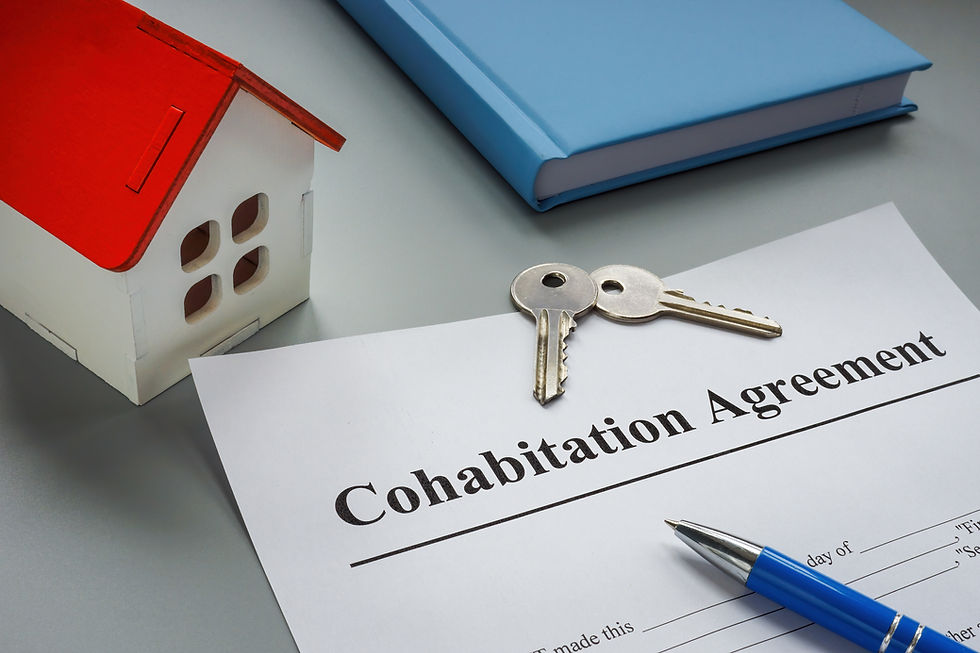Hiding Assets in a Trust during Divorce
- administration9514
- Jun 20, 2024
- 6 min read
In the P A F v S C F (788/2020) [2022] ZASCA 101 (22 June 2022) case, a wealthy Durban businessman’s was found that he had tried to hide R5.5 million from his wife by setting up an offshore trust and repaying a loan to his father. The Supreme Court of Appeal ruled in favour on his wife’s behalf and said this seemed like strange timing. Judge Tati Makgoka, who wrote the SCA judgment, explained that the default position in accrual calculations was that trust property was excluded. But a court could disregard this, if the trust was a “sham” or where there had been an abuse.
The parties got married to each other on 5 September 2001 out of community of property, with the accrual system. On 24 June 2013, the applicant (husband) issued summons against the respondent (wife) in the KwaZulu-Natal Division of the High Court, Durban (the high court) for a decree of divorce and financial relief. It was common cause that the value of the applicant’s estate had shown a greater accrual than the estate of the respondent. Accordingly, in her counterclaim, the respondent claimed an amount equal to one half of the difference between the accruals in the parties’ respective estates.
The divorce trial commenced in the high court on 18 February 2015. On 29 January 2015, 20 days before the commencement of the trial, the applicant founded a trust under the laws of the British Virgin Islands, in accordance with a settlement agreement between him and his brother, MJF, a solicitor practicing as Queen’s Counsel (QC) in the British Virgin Islands. The parties’ minor daughter was the sole beneficiary of the trust, and the applicant’s brother was its sole trustee. The applicant and the respondent were the residual trustees.
On 30 January 2015, a day after the trust was established, the applicant concluded a written deed of donation with the trust. In terms thereof, he donated a sum of £115 000 to the trust. The donation, which was irrevocable and unconditional, was payable a year later on 29 January 2016, or on the date of registration of transfer of an immovable property owned by the applicant in London, whichever occurred earlier. The donation (at the time, equivalent to R2 205 362) was paid to the trust in March 2015. Also, during the same month, the applicant transferred a sum of £125 000 (at the time, equivalent to R3 377 481) into the bank account of his father. This was repayment of a loan advanced to him by his father approximately 25 years earlier.
Upon becoming aware of these transactions, the respondent amended her counterclaim in September 2016 to include a prayer that the calculation of the accrual should consider the value of the two transactions. On 26 April 2017, the high court granted a decree of divorce, but reserved judgment on the determination of the proprietary consequences of the marriage. The court subsequently gave judgment on this aspect on 13 November 2017. The high court concluded that the two transactions were made with the ‘fraudulent intention’ of depriving the respondent of her rightful accrual claim. Consequently, it ordered, among other things, that the value of the two transactions be deemed to be part of the applicant’s assets for the purposes of calculating the accrual.
The high court granted the applicant leave to appeal to the full court. However, the applicant failed to prosecute his appeal timeously, and as a result, the appeal lapsed. Before the full court, the applicant abandoned the appeal against the order in respect of the payment to his father and applied for condonation of the late prosecution of the appeal to the full court and for leave to introduce further evidence on appeal. The full court dismissed both applications.
The issue before the SCA was whether the high court was correct in its order that the amount donated to the trust should be deemed to be part of the applicant’s estate for the purpose of calculating the accrual. The right to claim accrual is provided for in S3 of the Matrimonial Property Act 88 of 1984 (the MPA). That section provides that at the dissolution of a marriage subject to the accrual system, the spouse whose estate shows no accrual or a smaller accrual than the estate of the other spouse, acquires a claim against the other spouse for an amount equal to half of the difference between the accrual of the respective estates of the spouses.
Where trust property is involved, the default position is that such property does not form part of the personal estate of the trustee, except in so far as he or she, as trust beneficiary, is entitled to the trust property. A court can disregard this in two instances: where it finds that a trust is a sham or simulated, or when it finds that there has been abuse of the trust form. In Van Zyl NO and Another v Kaye NO and Others [2014] it was explained that the notion of a trust being a sham is premised upon the trust not existing. If it is found that a trust is a sham, the result is that no effect will be given to the transaction and the ‘founder’ will remain the owner of the ‘trust assets’ and neither the ‘trustee(s)’, nor the ‘beneficiaries’ will acquire any rights regarding these assets.
Although the accrual claim only arises at the dissolution of the marriage, both spouses acquire a protectable contingent right against each other during the subsistence of the marriage, which the law will protect in circumstances of irregularity and a lack of bona fides. Thus, upon vesting of such right, there is a legal obligation on both spouses to satisfy the accrual claim (and hence to share in their respective gains) at the dissolution of their marriage. Furthermore, s 7 of the MPA obliges both spouses to furnish ‘full particulars of the value’ of their estates. Therefore, an accurate reflection of the parties’ respective accruals is necessary to give effect to the intention behind the legislature’s provision of the accrual system in the first place.
Where there was an allegation that one of the spouses had sought to evade this obligation by abusing the trust form, for example, by transferring assets to a trust to reduce the value of their estate, and thus their accrual liability, a court is not prevented from enquiring into that issue. It is empowered to conduct an in-depth examination of the facts to determine whether trust form had been abused. If this is established in that factual enquiry, the court is empowered to pierce the trust veneer, and order that the value of such assets be considered in the calculation of the accrual. This power is not based on the authority of the MPA or in the exercise of a statutory discretion, but on the basis that a factual enquiry has revealed trust form abuse, upon which the piercing of the trust veneer follows.
The test whether trust assets should be taken into account when determining the patrimonial consequences of a marriage was set out in Badenhorst v Badenhorst [2005] ZASCA 116; 2006 (2) SA 255 (SCA) stating, to succeed in a claim that trust assets be included in the estate of one of the parties to a marriage there needs to be evidence that such party controlled the trust and but for the trust would have acquired and owned the assets in his own name.
The timing
The trust was created, and the deed of donation concluded, only days before the trial commenced. One of the issues in dispute was the value of the applicant’s estate, upon which the accrual payable to the respondent was to be calculated. The applicant offered no credible explanation for why he was genuinely motivated to create a trust for the parties’ daughter before the trial was due to start, where the issue of maintenance for the child was to be determined. What is more, although the quantum of maintenance was an issue in the divorce, the applicant had repeatedly stated that affordability was not an issue and that he could pay whatever the court decided was reasonable.
Although the timing of the creation is not decisive, it was one of the most important considerations. The applicant has not explained why he could not create the trust after the finalization of the divorce and payment of the respondent’s accrual. The inference was thus irresistible that the creation of the trust, and the hasty donation to it, were meant to thwart the respondent’s accrual claim.
Conclusion by the SCA
The SCA concluded that the high court was correct to conclude that it was entitled to go behind the trust form and order that the value of the donation to the trust be taken into account as part of the applicant’s assets in calculating the accrual. The appeal was correctly dismissed, and accordingly, there were no prospects of success on the underlying legal issue.
Rudolf Buys & Associates Attorneys has expert attorneys who have years of experience in dealing with divorce matters. Get an attorney from Rudolf Buys & Associates Attorneys to settle your divorce amicably and professionally.
.png)



Comments